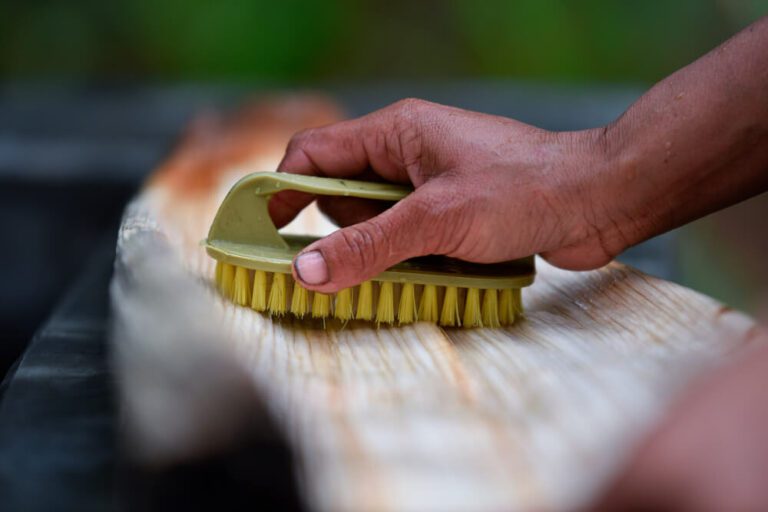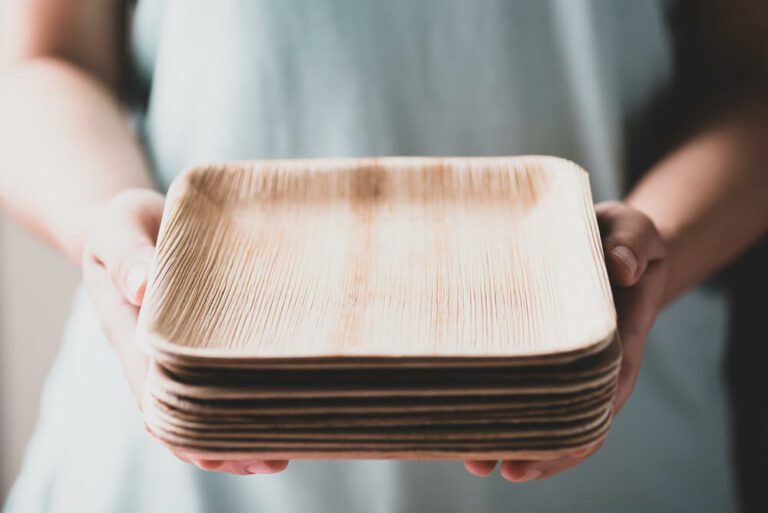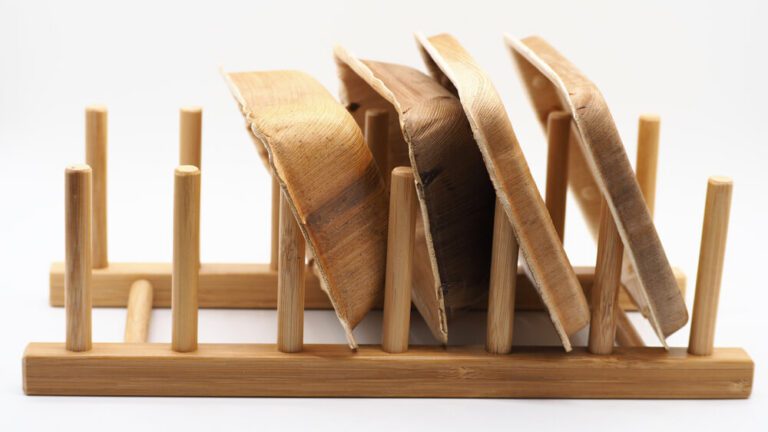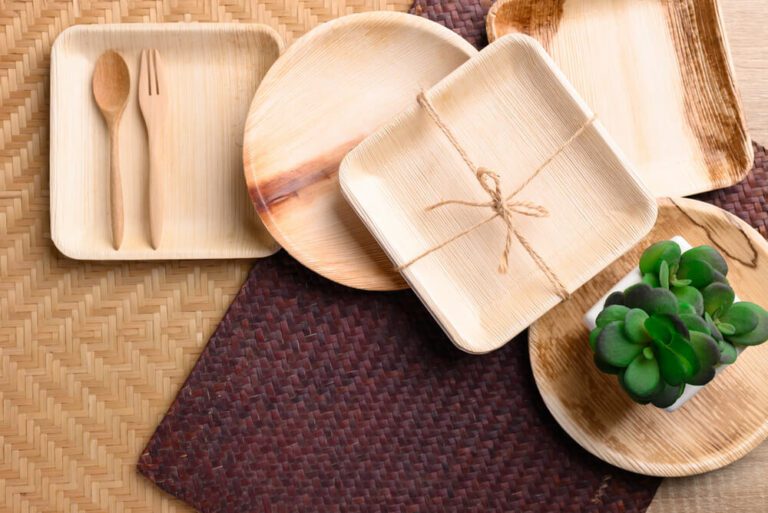In light of the recent upswing in demand for eco-friendly alternatives to conventional plastic tableware, many green-minded businesses, like Arbhu Enterprises, have embraced palm leaf plates. These plates are not only a greener alternative but also offer an unrivaled elegance that sets them apart from their standard paper or plastic counterparts. To fully grasp the significance of palm leaf plate manufacturing as a sustainable choice, let’s delve into the manufacturing process employed at Arbhu Enterprises.
The journey of creating palm leaf plates at Arbhu Enterprises begins with gathering naturally fallen leaves from the Areca palm tree, ensuring no harm to any living trees. These leaves are then meticulously sorted and cleaned, removing any traces of dirt or debris.
Afterward, the leaves undergo a steaming process to enhance their flexibility and make them more manageable. The steaming also serves as a sterilization step, eliminating any potential bacteria or insects that might be present on the leaves.
Explore Our Bulk Ordering Options
Discover the benefits of bulk ordering different products for your business – [Learn More]
Following the steaming, the leaves are pressed into the desired shape using a heated mold, providing the plates with their distinct form and texture. Post-molding, the plates are allowed to air-dry naturally under the sun, a process that may span several days depending on weather conditions.
One of the remarkable aspects of Arbhu Enterprises’ manufacturing process lies in its minimalistic approach, which limits waste and processing. The raw material, fallen leaves, is a natural byproduct, negating the need to fell trees specifically for this purpose. Furthermore, the plates are crafted exclusively from natural materials, free of any chemical additives or enhancers.
This detailed insight into the manufacturing process enables consumers to make informed choices and support sustainable practices. Opting for palm leaf plate manufacturing from Arbhu Enterprises means championing environmental responsibility and simultaneously enriching the dining experience with their unique elegance.
In essence, understanding the manufacturing process of palm leaf plate manufacturing at Arbhu Enterprises is vital for anyone committed to sustainability and eco-friendly practices. This knowledge empowers consumers to make conscious choices that support the environment, thereby endorsing eco-friendly practices within the manufacturing industry.
The Areca palm, scientifically known as Areca catechu, is a species of palm that is widely cultivated in various parts of the world. While it is predominantly found in the tropical Pacific, Asia, and parts of East Africa, India is a major contributor to global Areca palm cultivation.
According to the Food and Agriculture Organization (FAO) of the United Nations, India is the largest producer of areca nuts (the fruit of the areca palm), accounting for roughly 54% of global production as of 2018. This production is mostly spread across southern Indian states, particularly Karnataka, Kerala, and Assam.
This significant Areca palm cultivation has a substantial implication for palm leaf plate manufacturing. The trees shed leaves naturally throughout the year, providing a readily available source of raw materials for the production of palm leaf plates.
While the Areca palm leaves themselves have not been traditionally seen as a valuable resource, the emergence of sustainable tableware like palm leaf plates has changed this perception. Now, these leaves, which would otherwise have been waste material, are being used to produce biodegradable and eco-friendly products, thus contributing to a circular economy.
Related post: Wholesale Biodegradable Palm Leaf Plate: Affordable & Earth-Friendly Dining Solutions
Definition and Description of Palm Leaf Plates
Palm leaf plates are a type of eco-friendly disposable tableware that has been gaining popularity in recent years due to their sustainable and biodegradable nature. Local farmers in India and other tropical regions collect the naturally shed leaves of the Areca palm tree to make these plates.
Once the leaves are collected, they are thoroughly cleaned and soaked in water to make them pliable. Then, skilled artisans use a knife to cut the leaves into various shapes and sizes, depending on the desired end product. The cut leaves are then molded into plates, bowls, and other tableware items using heat and pressure.
One of the unique features of palm leaf plate manufacturing is their natural texture and appearance. The plates have a beautiful, rustic look that is perfect for outdoor events, rustic weddings, and other casual gatherings. They are also a great option for formal events, as they add a touch of elegance and sophistication to any table setting.
In addition to their aesthetic appeal, palm leaf plates are also highly durable and can withstand a wide range of temperatures and moisture levels. This makes them ideal for use in both hot and cold food applications, as well as for serving liquids and sauces.
Another benefit of palm leaf plates is that they are completely compostable and biodegradable. Unlike traditional plastic or paper plates, which can take hundreds of years to break down in a landfill, palm leaf plates will naturally decompose in just a few months, leaving behind no harmful residue or pollutants.
Overall, palm leaf plates are an excellent choice for anyone looking for a sustainable, stylish, and durable alternative to traditional disposable tableware. Whether you’re hosting a backyard barbecue or an elegant dinner party, these plates are sure to impress your guests while also helping to protect the environment.
It’s important to note that the production of palm leaf plates also supports local communities in India, where the plates are typically made. The process provides employment opportunities and supports small-scale industries, contributing to the growth of the local economy. In addition to being eco-friendly and sustainable, palm leaf plates are also durable and long-lasting. Unlike paper or plastic plates, which can easily tear or break, palm leaf plates are sturdy and can withstand heavy foods without bending or breaking. This makes them a reliable option for outdoor events, picnics, and barbecues. Furthermore, using palm leaf plates can also help reduce waste in landfills.
Plastic and paper plates can take hundreds of years to decompose, and they often end up in landfills, where they contribute to the growing waste problem. By choosing palm leaf plates, you can help reduce the amount of waste that ends up in landfills and promote a more sustainable future. Overall, the benefits of using palm leaf plates over traditional plastic or paper plates are numerous. From their eco-friendliness and sustainability to their durability and aesthetic appeal, palm leaf plates are a great choice for any event or occasion. So why not make the switch to palm leaf plates and help make a positive impact on the environment?
Sourcing Raw Materials for Palm Leaf Plates
The creation of palm leaf plate manufacturing begins with the process of sourcing raw materials. As palm leaves are collected from the ground, they are considered a waste product, making them an eco-friendly choice. However, it is important to practice sustainable and ethical methods when sourcing these leaves.
Introduction to the Types of Palm Leaves Used for Manufacturing Plates
There are several types of palm leaves that can be used for manufacturing palm leaf plates. Some of the most common types are areca palm leaves, coconut palm leaves, and banana leaves. Each type of palm leaf offers a unique texture and appearance to the finished product. Areca palm leaves are the most commonly used leaf for creating palm leaf plates due to their durability and strength.
Areca palm leaves have a natural waxy coating that helps protect them from moisture and insects. This coating also adds a subtle shine to the finished product, giving the plates a polished look. Coconut palm leaves, on the other hand, have a rougher texture and are often used to create more rustic-looking plates.
Sustainable and Ethical Practices in Sourcing
When sourcing palm leaf materials, it is important to practice sustainable methods that do not harm the environment. This includes choosing palm leaves that have fallen naturally from trees, avoiding the use of pesticides and chemicals in the process, and ensuring that the collection does not disturb wildlife or the natural ecosystem.
Many manufacturers also work closely with local communities to ensure that they are sourcing their materials in an ethical and responsible manner. This involves providing fair wages and working conditions for workers who are involved in the collection and processing of palm leaves.
Cleaning and Sorting the Palm Leaves
Once the palm leaves have been collected, they are then cleaned and sorted to remove any impurities or debris. This is done by hand, ensuring that only the best-quality leaves are selected for the manufacturing process.
During the cleaning process, any dirt or debris is removed from the leaves using water and a mild detergent. The leaves are then inspected for any imperfections or tears, which could affect the quality of the finished product.
Sun-Drying and Curing Process for the Leaves
The cleaned and sorted palm leaves are then left to dry in the sun for a specific amount of time to remove any residual moisture. This process also helps to impart a natural tan color to the leaves, giving them their signature aesthetic appeal. The leaves are then cured in a heated chamber to further strengthen them and prepare them for the next stage of the manufacturing process.
The curing process involves exposing the leaves to high temperatures for a set period of time. This helps to remove any remaining moisture and also helps to sterilize the leaves, ensuring that they are free from any bacteria or fungi.
Cutting and Shaping the Palm Leaves into Plate Molds
The cured palm leaves are then cut and molded into different shapes and sizes using specialized machinery. Manufacturers use different techniques to create various types of plates, including round plates, oval plates, and even bowls. Cutting and shaping the leaves into plate molds requires skill and precision to ensure that the finished product is of the highest quality.
Some manufacturers also use traditional techniques, such as hand-carving, to create unique and intricate designs on the plates. This adds an element of artistry and craftsmanship to the manufacturing process.
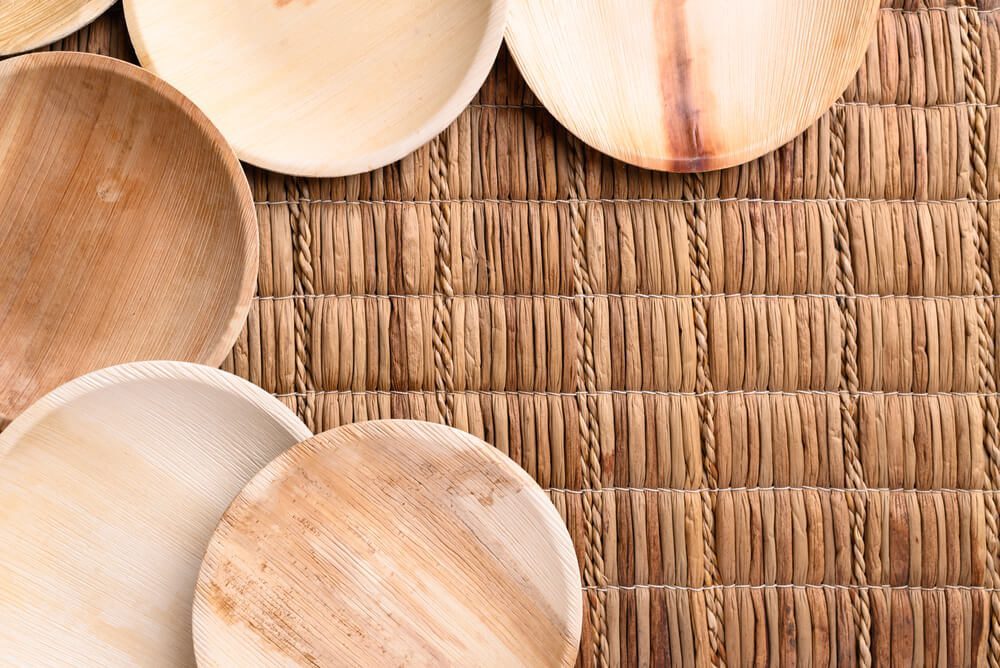
Techniques for Creating Different Plate Sizes and Shapes
The process of creating palm leaf plates involves several techniques that can be used to create various sizes and shapes of plates. The plates can be molded into different depths and curves, giving them a unique appearance and feel. Manufacturers also use different molds to create different plate sizes, allowing them to cater to a wide range of customers.
Some manufacturers also offer customizable options, allowing customers to choose the size, shape, and design of their plates. This adds a personal touch to the manufacturing process and allows customers to create plates that are tailored to their specific needs and preferences.
Related post: Going Green and Growing Profits: The Benefits of Starting a Palm Leaf Plate Business
Finishing Touches and Packaging
Before they are ready for use, palm leaf plate manufacturing go through several finishing touches to ensure their durability and strength. Manufacturers smooth the edges of the plates to remove any sharp edges that could be hazardous. They also apply natural coatings, such as vegetable oils, to the plates to give them added strength and durability.
Palm leaf plates are then packaged in boxes made from recycled material, completing the sustainable cycle. This eco-friendly packaging ensures that the plates are protected during transport and storage, making them a practical and sustainable option for any event.
Join the revolution for a healthier planet and reap the benefits for your business. Don’t wait—experience the unique charm of these plates firsthand. Request your free samples from Arbhu Enterprises today and embark on a journey towards a sustainable, profitable future. Order Free Samples
Reference Links:
Book a sample – https://arbhuenterprises.com/samples/
Tell us more – https://arbhuenterprises.com/kyc/
View our catalog – https://arbhuenterprises.com/all-products-catalog/
Book a meeting – https://arbhuenterprises.com/product-meeting/
FAQ Section
To assist consumers in making more informed choices about palm leaf plates, we have compiled a list of frequently asked questions and answers:
1. Are palm leaf plates microwave-safe?
Yes, palm leaf plates are microwave-safe and can withstand heat up to 350°F.
2. Are palm leaf plates compostable?
Yes, palm leaf plates are compostable and biodegradable, making them a sustainable choice.
3. Can palm leaf plates be used for hot and cold food?
Yes, palm leaf plates can be used for both hot and cold food items. They are versatile and can withstand high and low temperatures.
4. How are palm leaf plates different from plastic plates?
Palm leaf plates are environmentally friendly, chemical-free, and non-toxic. They are also compostable, biodegradable, and require less energy and water to produce than plastic plates.
5. How are palm leaf plates different from paper plates?
Palm leaf plates are more durable and long-lasting than paper plates. They are also eco-friendlier than paper plates, as they do not emit harmful substances into the environment when decomposed.
6. Are palm leaf plates reusable?
No, palm leaf plates are not reusable. However, they are a sustainable alternative to plastic or paper plates and can be recycled after use.
7. How are palm leaf plates disposed of?
Palm leaf plates are biodegradable and can be decomposed naturally without causing harm to the environment. They can also be added to a compost heap and turned into rich soil.
8. Can palm leaf plates be washed and reused?
No, palm leaf plates are designed for single-use only and cannot be washed or reused. However, they are a more sustainable alternative to plastic or paper plate
9. How do I know if the palm leaf plates I buy are ethically sourced?
Look for companies that prioritize ethical and sustainable practices when sourcing their palm leaf materials. You can also check their website or packaging to ensure that they source their palm leaves from reputable suppliers.
10. What types of events are palm leaf plates suitable for?
Palm leaf plates are suitable for a wide range of events, including weddings, picnics, barbecues, festivals, and more. They are versatile and eco-friendly, making them a great option for any occasion.


